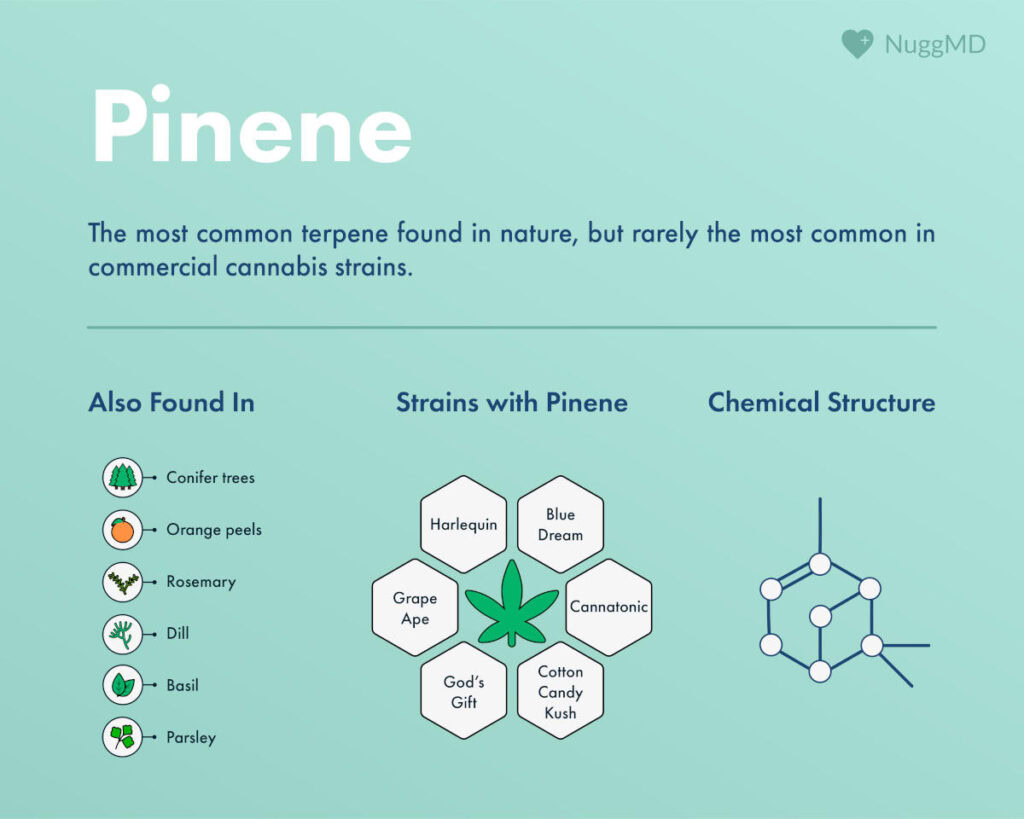Key Takeaways
- Pinene is a common terpene found in cannabis and many plants, known for its fresh, pine-like aroma.
- Research suggests pinene may support cognitive function, relaxation, and respiratory health.
- Strains like Jack Herer, Blue Dream, and Hindu Kush are rich in pinene, offering its distinct benefits.
While cannabinoids play a key role in cannabis effects, terpenes also contribute to how different strains smell, taste, and impact the body.
One of the most abundant terpenes in cannabis is pinene. Known for its fresh, piney scent, pinene may help support focus and relaxation. It may also have potential anti-inflammatory effects. The pinene terpene is in many other plants, including rosemary and conifers.
What is the Pinene Terpene?
Terpenes are aromatic molecules found in cannabis and most other plants. They play a key role in producing distinctive scents and potential effects. While there are hundreds of terpenes, pinene is one of the most common. It gives cannabis and other plants a fresh, pine-like aroma.
Pinene exists in two primary forms:
- Alpha-pinene (α-pinene) – Found in coniferous trees, rosemary, and basil. It's often associated with sharper, woodsy scents.
- Beta-pinene (β-pinene) – More common in plants like dill and parsley. It has a slightly spicier, earthier aroma.
Both forms of pinene are naturally abundant in cannabis strains. Some research suggests pinene may support cognitive function, mood, and relaxation. It might be a key player in the entourage effect. This effect is the theory that cannabis compounds work synergistically to enhance effects.1
What Does Pinene Smell Like?

As its name suggests, pinene has a distinctive, pine-like aroma. It's often described as fresh, woody, and earthy. Notably, it's the same scent found in evergreen trees, eucalyptus, and juniper.
However, pinene’s scent profile isn’t one-dimensional. Depending on the specific form and accompanying terpenes, it may also carry hints of:
- Herbs – Like sage, thyme, and basil.
- Citrus – A subtle sharpness similar to lemon zest.
- Spice – Mild undertones of black pepper or nutmeg.
Some cannabis consumers also report a slightly sweet or resinous scent in pinene-rich strains. Think of an aroma reminiscent of fresh forest air.
Beyond aroma, pinene may influence a cannabis strain's taste, adding a crisp, herbal quality to certain cultivars. Unsurprisingly, this terpene is widely used in essential oils and aromatherapy for its refreshing and invigorating properties.1
Effects and Benefits of Pinene

Like many terpenes, pinene may influence the body and mind in several ways. Current studies suggest alpha-pinene and beta-pinene may both play a part in cognitive support. They may also help with relaxation and provide anti-inflammatory effects.1
Potential benefits of pinene include:
- Cognitive Support – Some research suggests pinene may help support memory and focus. It may do so by interacting with neurotransmitters in the brain.
- Relaxation and Mood Support – Beta-pinene may interact with serotonin receptors. In turn, this may contribute to mood regulation.
- Anti-Inflammatory – Studies show pinene may reduce oxidative stress and inflammation.
- Respiratory Support – Pinene is known as a bronchodilator. That means it may help open airways and promote easier breathing.
Pinene is also commonly used in essential oils and aromatherapy. Here, it may provide a refreshing, energizing sensation. In cannabis, it may aid in the entourage effect, working alongside cannabinoids like THC and CBD to enhance overall benefits.
What Other Plants Contain Pinene?

Pinene is one of the most widespread terpenes in nature.
As a "bicyclic monoterpene," it exists as either alpha-pinene or beta-pinene. Both are found in many different plants.
Common sources of the pine-smelling terpene include:
- Coniferous Trees and Pine Nuts – As its name suggests, pinene is highly concentrated in pine trees, firs, and spruces. It’s a major component of conifers' liquid extracts (resins) and is even found in pine nuts.
- Herbs and Medicinal Plants – It's abundant in sage, ironwort, and big sagebrush, among countless other plants. Many of these plants have been traditionally used in herbal medicine.
- Resins and Essential Oils – Frankincense, juniper, and eucalyptus oil all contain high amounts of pinene. Some essential oils contain an even mix of both α-pinene and β-pinene, lending to more potent effects.
- Citrus Peels – The peel of Makrut lime is particularly rich in beta-pinene. Alongside limonene, it contributes to many citrus fruits' sharp, aromatic scent.
Alpha-pinene is the most widely encountered terpenoid in nature. Interestingly, it's known to be highly repellent to insects. This protective property explains why so many plants produce pinene. It helps defend against herbivores while contributing to their distinct, fresh scents.1
What Conditions Can Pinene Help With?
For centuries, pinene-rich plants have been used in traditional remedies. Long before scientists began isolating terpenes, humanity reaped the benefits.
Scientists are still researching potential benefits of pinene, but modern research is catching up today and revealing potential effects in several key areas
First, it is currently being studied for potential neuroprotective effects. Studies suggest that the terpene may help protect neurons against oxidative stress. Since oxidative stress plays a role in cognitive decline, it may help keep consumers sharp for longer.
Some research suggests that beta-pinene interacts with serotonin receptors. As a result, the terpene may provide potential mood-supporting properties.
It can potentially also influence inflammatory pathways in the body. Doing so may help consumers with pain perception and inflammation.
Finally, current findings suggest that pinene acts as a mild natural bronchodilator. Put simply, it may help open airways to promote easier breathing, though this doesn't mean that it can replace bronchodilators used to treat asthma. It's also worth noting that any benefits of pinene on opening the body's airways would likely be overshadowed by the harms of smoking.
Anecdotal reports suggest that pinene-rich strains often provide a crisp, refreshing sensation. This may help clear the mind and enhance focus.
Best Strains for Pinene

These strains are some of the industry's most iconic and legendary names. They're popular for their effects, but also share a rich pinene profile that contributes to their distinctive aromas.
1. Jack Herer
Named after the renowned cannabis activist, Jack Herer is a sativa-dominant hybrid celebrated for its uplifting and clear-headed effects. Rich in pinene, this strain offers a pine-like aroma complemented by hints of spice and citrus. Users often report enhanced focus and creativity, making it a popular choice for daytime use.
2. Blue Dream
A balanced hybrid originating from California, Blue Dream combines relaxing indica with a cerebral sativa. Pinene's fresh pine scent underscores its sweet berry aroma. Consumers often choose Blue Dream because they believe it helps to reduce stress and promote a gentle euphoria without heavy sedation.
3. Gelato
Famous for its dessert-like flavors, Gelato blends sweet, fruity notes with a subtle pine freshness from its pinene content. The presence of pinene adds a subtle pine freshness to its profile. Consumers often report a relaxed yet euphoric experience, perfect for socializing or winding down.
4. Dutch Treat
Dutch Treat is a staple in Amsterdam coffeeshops, an indica-dominant hybrid with dense, resinous buds and a rich pine scent. High levels of pinene contribute to its characteristic pine aroma. Consumers often report that it melts away stress while keeping the mind clear and uplifted.
5. Hindu Kush
This one's more of a "pure indica," with roots in the mountainous regions of its namesake. Consumers cherish Hindu Kush for its deeply relaxing, full-body effects. Its earthy, pine-heavy aroma directly results from its pinene-rich terpene profile, making it a classic choice for unwinding at the end of the day.
Overall, these strains showcase the role of pinene in shaping both aroma and effects. Whether seeking focus, relaxation, or a bit of both, pinene-rich strains remain some of the most iconic in cannabis history.
References
- Weston-Green K, Clunas H, Jimenez Naranjo C. A Review of the Potential Use of Pinene and Linalool as Terpene-Based Medicines for Brain Health: Discovering Novel Therapeutics in the Flavours and Fragrances of Cannabis. Frontiers in Psychiatry. 2021;12. doi:https://doi.org/10.3389/fpsyt.2021.583211 ↩︎
The information in this article and any included images or charts are for educational purposes only. This information is neither a substitute for, nor does it replace, professional legal advice or medical advice, diagnosis, or treatment. If you have any concerns or questions about laws, regulations, or your health, you should always consult with an attorney, physician or other licensed professional.




